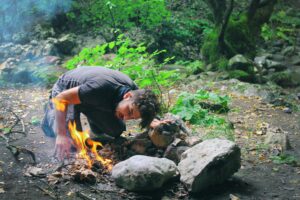Skills For Bugging Out – Survival Techniques
Skills For Bugging Out – Survival Techniques: The more skills you develop, the more you rely on yourself, and your chances of survival grow. We'll go over some basic survival techniques and demonstrate how to use them. Protect yourself and your loved ones in the event of a crisis.
These are the characteristics and fundamental survival abilities you must cultivate when you are on your own, without the safety net of a functioning civilisation.
Keep a positive mental attitude.
Find and treat/filter water
Locate or build a shelter.
Obtain and prepare food.
Be able to ignite a fire on a regular basis.
The optimistic mental attitude
This is more important than the others since relying on your capacity to wring survival from your environment would doom you the moment you give up hope. There are several wonderful stories of people who have survived avalanches, fires, floods, and long periods of solitary because of their unflinching desire to persevere. They are everyday people who refuse to accept defeat. In any situation, a positive mental attitude allows you to never give up on yourself.
Here are some examples of how to develop this mindset:
Set daily or even hourly objectives, such as ascending the next ridge or eating lunch at a local restaurant. Please ensure that they are measurable and geared toward a specific goal. Each stage you complete enhances your confidence in your basic survival skills as well as your psychological well-being.
Concentrate on what you can alter – After a horrific disaster, focusing on the injustice of the situation or the loss that has occurred will not help you. Concentrating on building a shelter or staying dry, on the other hand, will be advantageous. Concentrating on improving your situation will assist you both short and long term. Ignore the bigger picture and focus entirely on improving your current situation.
Consume enough liquids and food to provide you with the energy you need to defy the odds. It is vital to have a steady supply of water and food. You won't be trying to eat every day, but meeting your basic calorie and moisture needs will be enough to keep you going. Aiming for 2400 to 3600 calories per day is a good place to start. Once this need has been met, you can focus on your rehabilitation or finding help.
Be visibly positive because positivity generates positivity. If you show the other survivors that you have a positive outlook, the group will not break under the weight of the disaster. Be the seed that nurtures your team's morale.
Water
Aside from your inner strength, water is the most important resource you'll need. Finding it and preparing it for use are two of the most important fundamental survival skills you must learn.
You must be informed of how to identify water-related ailments. This could include looking at where plants are growing, where the earth slopes, building a natural water trap or studying animal activities to identify where they get their water.
Identifying possible water sources along the way is tremendous assistance if you can map a course as part of your escape strategy.
To ensure that the water is safe to drink, any impurities must be removed.
Drinking contaminated water can be fatal.
Filtration is the process of passing water through extremely small membranes in order to remove particles and bacteria. Some pathogens are capable of evading even the most advanced filters.
Purification is the process of purifying water using chemicals such as iodine or ultraviolet light sources. Although this eliminates all bacteria, it does not remove the particles.
Boiling: This method of purification kills all bacteria but does not remove particles. The water should be heated for at least one minute to disinfect it.
Because the benefits of filtration and purification differ, it is recommended that both processes be used to attain 100 per cent water safety, thereby employing a combination of both. The most basic method is to boil water after it has been passed through a cloth. A preferable method, though, is to run the water through a filter system before purifying it with Steripen tablets. These items should be on any list of emergency kit requirements.
Possibility of collecting rainwater
Use a solar still, which you can buy or create with items from your survival kit. The heat from the sun is utilised to evaporate the liquid in a solar water heater, allowing you to reuse it as clean drinking water.
Recognize your water requirements: A human may spend 72 hours without water. However, it is recommended that an active person consume 75% of their body weight in ounces each day.
Food
Hiking with your bug out bag of survival materials burns between 400 and 500 calories each hour. It is vital to maintain your body energised so that it can function like a well-oiled machine.
First and foremost, ration your food supplies. It's a matter of survival, not feasting. When you're hungry, eat small amounts but don't overdo it.
Food gathered from the environment can be used to boost your rations. This requires being aware of edible plants in the area as well as understanding how to pick them. Find out where these plants can be found. Is there a certain berry that grows near watering holes? Is it better to place a calorie-rich plant in the shade? Learn about these aspects so you can find nutrition where you need it. Some plants can only be eaten after they have been cooked or decocted. Learn how to prepare your local flora so that it can be eaten. Also, educate yourself on what is risky or poisonous so that you do not become ill!
Learn about the animals that live in your area. This includes both potential predators to avoid and prey to seek. Learn about the environments in which these creatures live. Is there a particular type of fish that prefers eddies and swirls? Look for them specifically if you want to find them. Is there an animal in your area that prefers to eat a certain plant? It may be beneficial to set snares around these plants. Learn how to prepare these animals as well as how to cook them. The profession includes skinning and butchering animals, as well as filleting fish.
Survival Shelters
A well-prepared person will have a way to shelter from the elements as part of their emergency pack. A prepared person, on the other hand, will have learnt to build survival shelters as one of their basic survival skills. It is not necessary for a survival shelter to be smart or elegant. Nonetheless, it should keep rain and snow out, heat in, and be made from readily available materials.
Building rubble, foliage, animal hides, a tarp, or a poncho can all be used to make survival shelters.
Consider including paracord and a survival saw or hatchet in your emergency kit, as these can be your best friends when it comes to constructing a shelter. With these supplies, you can easily build a survival shelter out of nearly anything.
If you don't have paracord, zip ties, duct tape, or another binding material, you can build a primitive rope form out of strips of tree bark, little green trees, branches, and vines.
A simple survival shelter could be built by erecting a structure out of long, rigid materials like branches or 2x4s and covering it with a poncho or tarp.
If a poncho or tarp cannot be used, place a brush on top of the frame that slopes to the ground to insulate the heat and keep moisture out.
Fire
In a survival situation, fire can serve a variety of tasks, and both starting and maintaining a fire are basic survival skills. A fire boosts morale by providing heat and light, as well as the ability to cleanse water and cook food.
The three main elements for starting a fire are air, fuel, and an igniting source.
Because fire eats air voraciously, it is vital that it be built in such a way that air may flow into the combustion. Don't suffocate the fire by adding too much fuel.
Fuel: This is what burns in a fire and can come from a variety of sources. When a branch or stick snaps neatly, that means it's dry and ready to burn. Even if it splinters and bends, it will remain green and smokey, stifling the fire.
As an ignition source, a lighter, matches, or a portable fire starter can be utilised. However, as part of your fundamental survival skills, you should learn more rudimentary fire-starting techniques in case these items are not available.
Layers of progressively larger wood are used to build a fire. To begin, you need fuel that is tiny, dry, and easily ignited. Tinder is made out of many materials such as tree bark, dryer lint, coconut shells, and pine needles. You work your way up from tinder to kindling, which is usually a stick the size of your little finger. Then there's the small amount of firewood the size of your thumb. Add more wood gradually until you have a large enough fire to light logs. The majority of the coals in a fire pit are made up of these logs.
Learn how to cook over an open flame. Coal cooking is more efficient than cooking over an open flame. Coals produce more uniform heat and allow you to control the rate at which your food cooks, rather than burning some areas and leaving the inside uncooked. An open flame, on the other hand, is preferable for boiling water.
The two most common forms of fires are teepees and log cabins.
A Dakota fire pit is a less common yet more efficient alternative.
Without a doubt, knowing basic survival techniques will increase your odds of survival greatly. You will be better prepared and able to fend for yourself and your family in a disaster if you devote some time now to studying these basic survival skills.
The post Skills For Bugging Out – Survival Techniques appeared first on https://gqcentral.co.uk




